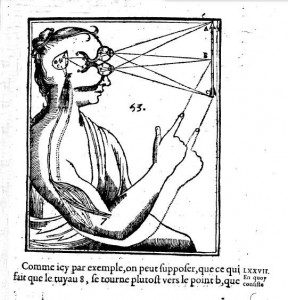When René Descartes searched through the human brain to find the Seat of the Soul, he settled on the pineal gland, a small endocrine organ found in nearly all vertebrates. It seemed like a good candidate, because it is a singular organ, not duplicated on each half of the brain but perched right on the midline, where it could, as Descartes imagined, receive sensory impressions through little pipes, and flex the muscles of the body by exhaling “animal spirits” along a system of hoses leading to the arms and legs.

Illustration from Traité de l’Homme (1644), showing the teardrop-shaped pineal gland perched in the skull like a little Mecha-pilot.
Descartes’ soul sits at the control centre of the meat-puppet, gathering news of the world through its eyes, ears and nose and exerting its will upon the world through the pneumatic machinery of the body.
It is easy to recognize in his conception a structure analogous to what we know as the nervous system. We no longer think in terms of “animal spirits,” but rather of “neural signals,” and we no longer place the mind within any particular gland in the brain. But for most of us, who have only a rough understanding of how it all works, this “signal/transmitter/receiver” scheme is only another metaphor, just a little more sophisticated than the one Descartes used. By and large, we are still operating with the notion of an insubstantial mind somehow localized within a “central” nervous system, conducting its business with the world through an extensive network of bodily filaments.
Indeed, many of us find it hard to even conceive of an intelligence which is not concentrated at the top of a hierarchy, running from the brain (where the cogitating self resides) to the tips of the peripheral nerves, where the world lies waiting to be felt, heard and seen.
So, the distributed intelligence of the octopus nervous system–half of its neurons are in its arms!--strikes us as something bizarre and wondrous, requiring further exploration and explanation. Challenging the naive expectation that cognitive processing should be “central” and the organs of sensation “peripheral,” the octopus researchers have devised ingenious experiments to show that the arms of the mollusc continue to perform goal-oriented behaviours, like prey-seeking, exploration and danger-avoidance even when they are severed from the so-called brain.
And if it seems marvelous that a detached octopus arm can still sense and react to perceived danger, how much weirder is it that a single cell can do all these things, without the benefit of any nervous system at all? But this is perfectly commonplace in the protist world, where one-celled hunters swim around, stalking one-celled victims, who recoil when they sense trouble, take shelter in their shells, or hide from their enemies in clumps of debris.
Just imagine if a single cell of your body could cut loose and go wandering about under its own power like that, hunting and consuming prey! Oh, right…they do. In fact, it is perfectly ordinary for eukaryote cells, whether they are inside larger organisms or roaming at large in the “world,” to exhibit complex behaviours that may be remarkably hard to distinguish from the kinds of behaviours we observe in large, multicellular animals.
Take a ciliate like Stichotricha aculeata. It usually inhabits a shabby, homemade tubular dwelling (a lorica), made up of mucus mingled with debris. It lives by brushing smaller organisms — bacteria and some of the daintier protists — into a mouthlike aperture, where they are packed up in little food-bubbles (vacuoles) and digested. Like a cat or a crayfish, it is both large enough to be a predator, and small enough to be prey. Consequently, it is a cautious creature, relying on its lorica for protection. When it senses trouble, it withdraws into its tube, and when the coast is clear it will put out its long feeding apparatus. Like other ciliates, it can sense movement (probably with the help of sensory cilia, which are common in eukaryotic cells), and is easily startled. If you should tap on the microscope stage with your finger, while you are watching it, it will detect the vibrations and pull back. After hiding for a while in its jelly-tube, it will extend its proboscis, tentatively. If it encounters no more trouble it will begin to feed again.
However, if the disruption is sufficiently violent or prolonged, it may abandon its lorica altogether, as the closely-related Chaetospira does in a video I recorded last year. The Stichotricha in the embedded footage which follows has already fled its original “home,” and taken shelter in a little enclosed space, between the coral-like tubular dwelling of a colonial flagellate called Rhipidodendron huxleyi, and a mucoid colony of some other organism (Spongomonas?). In this makeshift lorica-substitute, it is behaving exactly as it normally does when at home, sliding forward and back, feeding, withdrawing, advancing, always hungry, and always vigilant:
It is easy to see why early microscopists referred to these creatures as “animalcules: “very small animals”. Without a nervous system, ciliates like Stichotricha and Chaetospira exhibit behaviours strikingly reminiscent of a fish lurking in a crevice, or a case-dwelling insect, like the larval caddisfly. If they often remind us of “true” animals, it is well to remind ourselves that, after all, they have a way of life that differs very little that of other cavity-dwelling aquatic creatures, like the ones we might find on a coral reef, or like this larval midge, in the gravel of a freshwater stream:
